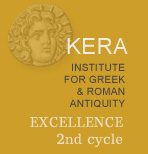Inscriptions found at the Sebasteion
The inscriptions of the Sebasteion were first seen and copied in 1967 by a Turkish archaeologist working for the archaeological museum of Burdur. Following the confiscation of a bronze torso that had been brought to light by looters, Mehmet Yılmaz conducted a rescue excavation at the site on behalf of the museum. As Jale İnan has conclusively established, that torso originally belonged to a famous group of bronze statues that surfaced in America in the 1960s (İnan 1977; 1993; 1994). Like the torso in the Burdur Museum, the statues now owned by different collections in the United States had been unearthed in illegal excavations at the Sebasteion of Boubon. Yılmaz's rescue excavation brought to light a 4.80 x 6.50 m room, in which inscriptions on two pedestals along the north and the east walls attested a number of statues of emperors and members of the imperial household. The excavation also uncovered four individual bases set against the west wall, three of which were inscribed. After the rescue excavation of 1967, the building was again buried. The inscriptions were published by C.P. Jones based on majuscule copies and photographs of M. Yılmaz. The Sebasteion was excavated a second time in 1990 by J. İnan on behalf of the museum in Burdur. It is now accessible to visitors. The inscriptions are presented here clockwise from the west corner of the north pedestal. With a few exceptions, mainly concerning the individual bases of the west wall, this sequence corresponds also to their chronological order.

